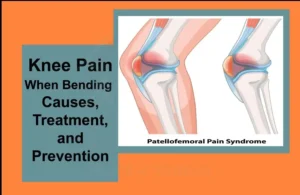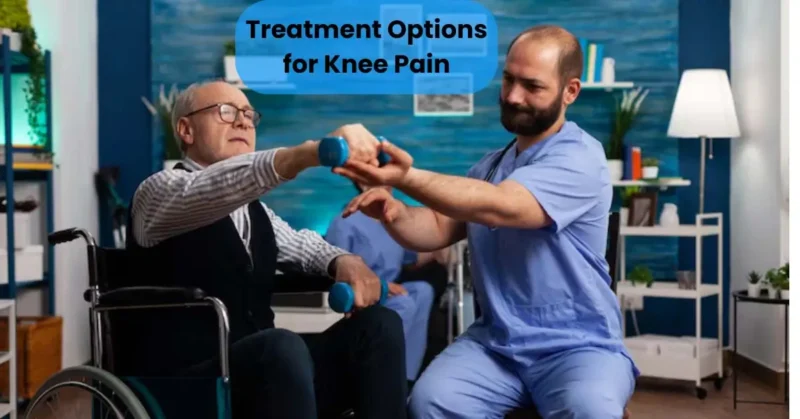Struggling with knee pain when bending? Uncover the top causes, effective treatments, and simple prevention strategies to ease discomfort and protect your joints.
Thank you for reading this post, don't forget to subscribe!How to Get Prevention Tips for Knee Pain When Bending
Knee pain is a common complaint that affects individuals of all ages. The complexity of the knee joint, which is responsible for bearing much of the body’s weight, makes it susceptible to various injuries and conditions. Knee pain, specifically during bending, can significantly impact daily activities and quality of life.
Knee pain when bending can turn everyday tasks, like climbing stairs or sitting down, into uncomfortable challenges. Whether it’s a sharp twinge or a dull ache, this type of pain often signals an underlying issue such as joint strain, cartilage wear, or inflammation. Ignoring the discomfort can lead to long-term problems, but with the right knowledge, relief is within reach. In this guide, we break down the common causes, expert-recommended treatments, and smart prevention tips to help you move freely and confidently again.
Anatomy of the Knee Joint
The knee joint comprises bones, cartilage, ligaments, tendons, and muscles. The prominent bones include the femur (thigh bone), tibia (shin bone), and patella (kneecap). These components work together to facilitate movement and provide stability.
Common Causes of Knee Pain When Bending
-
Patellofemoral Pain Syndrome (PFPS)
Patellofemoral Pain Syndrome, often referred to as “runner’s knee,” is a common cause of knee pain, particularly during activities that involve bending. This condition arises when the patella (kneecap) does not move smoothly along the femur groove. Contributing factors include muscle imbalances, overuse, and improper footwear.
-
Osteoarthritis
Osteoarthritis is a degenerative joint disease that can cause knee pain when bending. It occurs when the cartilage that cushions the ends of the bones in the knee joint deteriorates over time. Symptoms include pain, swelling, and reduced range of motion.
-
Meniscus Tears
The meniscus is a C-shaped piece of cartilage that acts as a shock absorber between the femur and tibia. Tears in the meniscus are common in athletes and can result from sudden twisting movements or direct trauma. Symptoms include pain, swelling, and difficulty bending the knee.
-
Ligament Injuries
Ligament injuries, such as tears to the anterior cruciate ligament (ACL) or medial collateral ligament (MCL), can cause significant knee pain when bending. These injuries often occur during high-impact sports or activities involving sudden direction changes.
-
Tendonitis
Tendonitis, particularly patellar tendonitis, involves inflammation of the tendons around the knee. Overuse and repetitive stress often lead to knee pain during knee-bending activities.
Diagnosing Knee Pain
An accurate diagnosis of knee pain requires a thorough evaluation by a healthcare professional. This process typically includes:
- Medical History: Review the patient’s symptoms, medical history, and activity levels.
- Physical Examination: Assessment of the knee’s range of motion, stability, and tenderness.
- Imaging Tests: X-rays, MRIs, or CT scans to visualize the internal structures of the knee.
Treatment Options for Knee Pain
-
Rest and Activity Modification
Resting the knee and steering clear of activities that aggravate pain are crucial first steps in the treatment process. It’s important to listen to your body and allow sufficient time for healing. In addition, modifying your daily activities can significantly reduce stress on the knee joint. This could involve adjusting your exercise routine, using supportive gear such as knee braces, or choosing low-impact activities like swimming or cycling. By making these changes, you can help alleviate symptoms and promote a quicker recovery.
-
Physical Therapy for Knee Pain
Physical therapy is a highly effective treatment option for a wide range of knee pain causes, including injuries, arthritis, and post-surgical recovery. A licensed physical therapist conducts a thorough assessment to understand the specific nature of your knee pain and develops a tailored exercise program. This program focuses on strengthening the muscles surrounding the knee, which play a crucial role in supporting joint function and stability.
Additionally, the exercises aim to improve flexibility in the surrounding muscles and ligaments, making it easier to perform daily activities and reducing the risk of further injury. The therapist may also incorporate techniques such as manual therapy, stretching routines, and modalities like ice or heat treatment to facilitate recovery and enhance overall joint stability. By actively participating in a personalized physical therapy program, individuals can expect to alleviate pain, restore mobility, and improve their quality of life.
-
Medications
Nonsteroidal anti-inflammatory drugs (NSAIDs), including medications such as ibuprofen and naproxen, are commonly used to relieve pain and reduce inflammation. These drugs work by blocking the production of certain chemicals in the body that contribute to pain and swelling, making them effective for treating a variety of conditions, including arthritis, muscle strains, and headaches.
In cases where pain is more severe or persistent, healthcare providers may recommend corticosteroid injections. These injections deliver a potent anti-inflammatory medication directly to the site of pain, providing quicker relief and reducing inflammation more effectively than oral medications in some situations. This approach is often used for conditions such as joint disorders or severe tendonitis, where targeted treatment can lead to significant improvements in mobility and pain management. Always consult with a healthcare professional to determine the most appropriate treatment option for your specific needs.
-
Surgery
Surgical intervention may be necessary for severe cases or when conservative treatments fail. Standard surgical procedures include:
- Arthroscopy for meniscus tears.
- Ligament reconstruction for ACL injuries.
- Partial or total knee replacement for advanced osteoarthritis.
Preventing Knee Pain
Preventing knee pain is essential for maintaining mobility and overall quality of life. To effectively protect the knee joint, it’s important to adopt a combination of healthy habits and proactive measures. In addition, home remedies can play a significant role in alleviating knee pain. Here are some comprehensive strategies to consider:
- Regular Exercise: Regular physical activity is crucial for strengthening the muscles that support the knee. Low-impact exercises, such as swimming, cycling, and walking, are particularly beneficial as they minimize stress on the joints while providing an effective workout. Strength-training exercises that target the quadriceps, hamstrings, and calf muscles can help improve joint stability and reduce the risk of injury. Aim for at least 150 minutes of moderate aerobic activity per week, along with two days dedicated to strength training.
- Weight Management: Maintaining a healthy weight is vital for reducing pressure on the knee joints. Excess weight can exacerbate knee pain and increase the risk of developing osteoarthritis. A balanced diet rich in whole foods, including fruits, vegetables, lean proteins, and whole grains, can support healthy weight management. If you’re looking to lose weight, consider consulting a healthcare professional or nutritionist for personalized guidance.
- Proper Footwear: Wearing supportive and well-fitted shoes is essential for knee health. Footwear should provide adequate cushioning and stability, particularly if you engage in activities like running or walking. Look for shoes with good arch support and shock absorption. Avoid high heels and flip-flops, as they can contribute to improper alignment and increase knee strain.
- Stretching and Flexibility: Incorporating stretching exercises into your daily routine helps maintain muscle flexibility and prevent imbalances that can lead to knee pain. Focus on stretches that target the quadriceps, hamstrings, calves, and hip flexors. Yoga and Pilates can also enhance overall flexibility and provide strengthening benefits, contributing to better knee support.
- Avoiding Overuse: Listen to your body and avoid activities that cause strain or discomfort in your knees. Be mindful of repetitive motions, such as squatting or kneeling, which can lead to overuse injuries. If you engage in sports or high-impact activities, consider cross-training to reduce the risk of overloading the same muscle groups.
Adopt these strategies and monitor your activity levels to reduce the risk of knee pain and improve long-term joint health.
When to Seek Medical Help
It is essential to seek medical attention if knee pain persists despite self-care measures or if the pain is severe. Additional signs that warrant a medical evaluation include the following:
- Inability to bear weight on the knee
- Significant swelling or redness
- Knee deformity
- Fever associated with knee pain
FAQs on Knee-Bending
Q. How do you treat knee pain when bending?
To treat knee pain when bending, consider the following steps:
- Rest: Avoid activities that aggravate the pain.
- Ice: Apply ice packs to reduce swelling and numb the area.
- Compression: Use a knee brace or wrap to provide support.
- Elevation: Keep the knee elevated to decrease swelling.
- Medication: Take over-the-counter pain relievers such as ibuprofen or acetaminophen.
- Physical Therapy: Engage in exercises to strengthen the muscles around the knee and improve flexibility.
- Professional Consultation: Visit a healthcare provider for a thorough evaluation and personalized treatment plan, which may include corticosteroid injections or surgery in severe cases.
Q. Which treatment is best for knee pain?
The best treatment for knee pain varies depending on the cause and severity of the condition. Common effective treatments include:
- Physical therapy: tailored exercises to strengthen the knee and improve mobility.
- Medications: nonsteroidal anti-inflammatory drugs (NSAIDs) to reduce pain and inflammation.
- Injections: corticosteroid injections for severe inflammation and pain relief.
- Surgery: procedures like arthroscopy, ligament reconstruction, or knee replacement for severe or persistent cases.
Q. How can I stop the pain in my knee?
To stop knee pain, follow these steps:
- Rest and Avoid Strain: Limit activities that put stress on your knee.
- Use Ice and Heat Therapy: Apply ice to reduce swelling and heat to relax muscles.
- Wear supportive shoes. Use shoes with good arch support to minimize knee strain.
- Maintain a Healthy Weight: Reducing body weight decreases the load on your knees.
- Regularly: Perform low-impact exercises like swimming or cycling to strengthen the knee.
- Consult a professional: Seek advice from a healthcare provider for a personalized treatment plan.
Q. What stops the knee from bending?
Several conditions can prevent the knee from bending properly:
- Meniscus Tears: Damage to the cartilage can impede knee movement.
- Ligament Injuries: Tears in the ACL, PCL, MCL, or LCL can limit knee flexibility.
- Osteoarthritis: Degeneration of joint cartilage can cause stiffness and limit bending.
- Swelling and Inflammation: Conditions like bursitis or tendinitis can cause swelling that restricts knee movement.
- Joint Effusion: accumulation of excess fluid in the knee joint.
Q. What food is good for knee pain?
Certain foods can help reduce knee pain by decreasing inflammation and supporting joint health.
- Fatty Fish: Rich in omega-3 fatty acids (salmon, mackerel, and sardines).
- Fruits and vegetables: high in antioxidants (berries, spinach, kale).
- Nuts and seeds contain anti-inflammatory properties (walnuts, chia seeds).
- Olive oil contains oleocanthal, which has anti-inflammatory effects.
- Whole grains help reduce inflammation (oats, brown rice, quinoa).
Q. What can I drink to stop knee pain?
Certain beverages can help alleviate knee pain by reducing inflammation:
- Water: Staying hydrated helps maintain joint lubrication.
- Green tea contains antioxidants and anti-inflammatory properties.
- Tart Cherry Juice: Known to reduce inflammation and muscle soreness.
- Turmeric milk contains curcumin, which has potent anti-inflammatory effects.
- Bone broth is rich in collagen and nutrients that support joint health.
Conclusion
Knee pain when bending is standard due to various conditions and injuries. Understanding the underlying causes, seeking appropriate treatment, and adopting preventive measures can help manage and alleviate knee pain effectively. If you experience persistent or severe knee pain, consult a healthcare professional for a comprehensive evaluation and personalized treatment plan.
Read more articles on Health and Wellness Tips.
You might like to read:
Ease Knee Pain at Home: Remedies for Instant and Long-Term Relief



